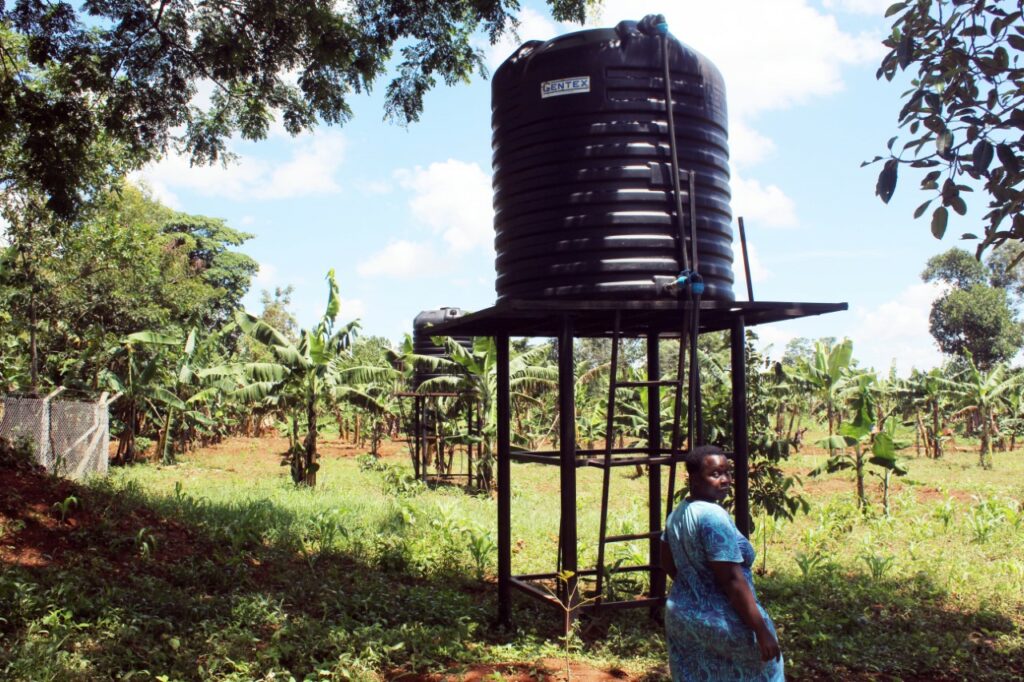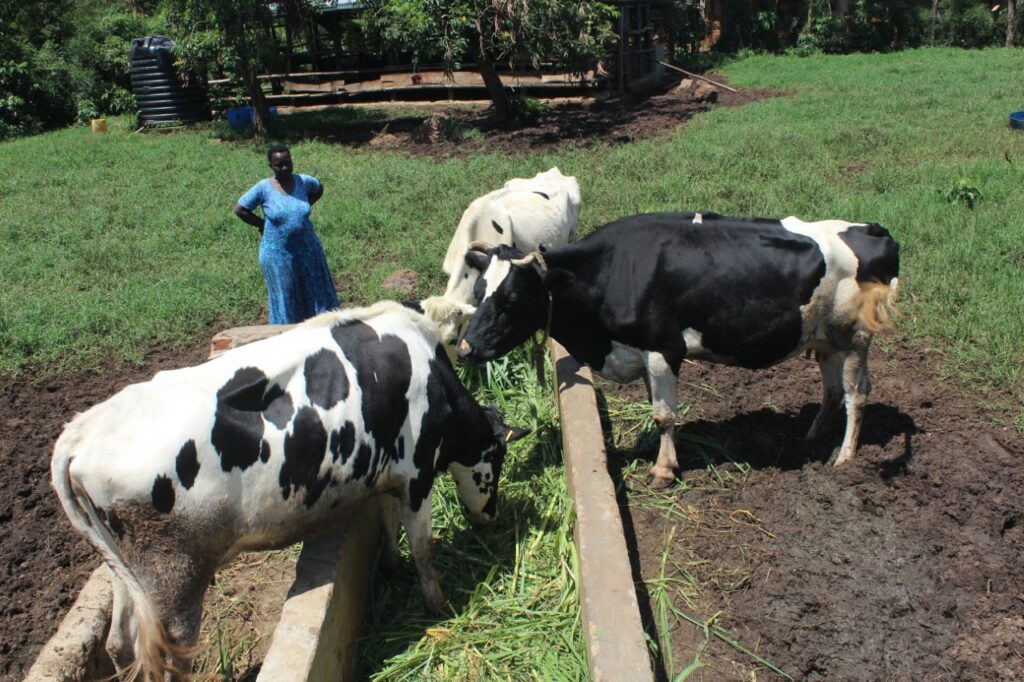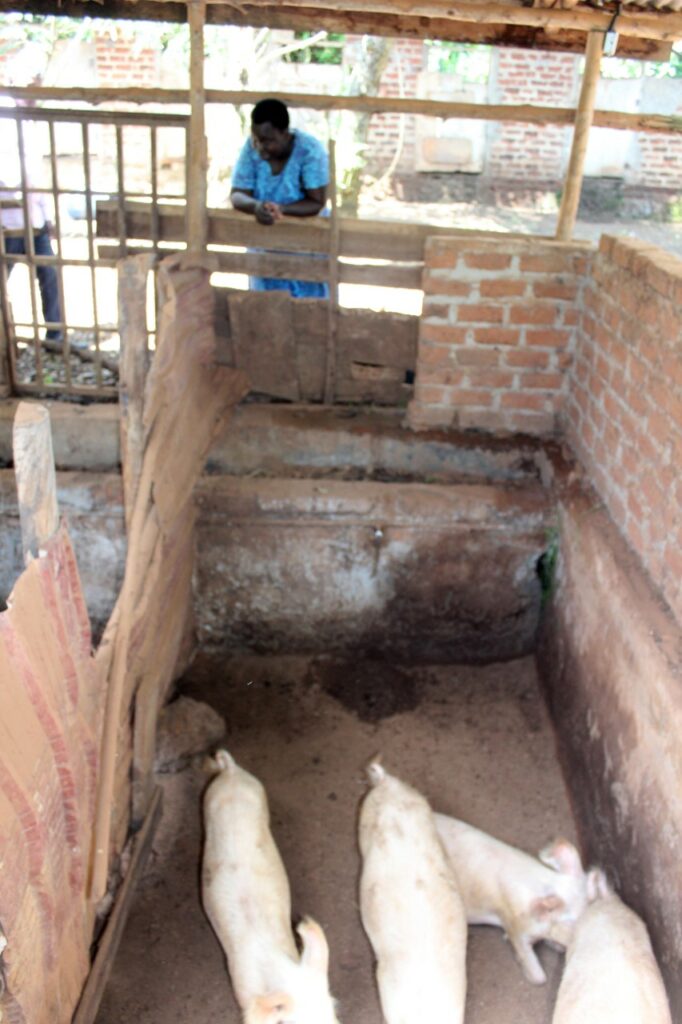By George Bita
Rose Esther Namuganza, 49, swapped for the hoe in 2015.
Some colleagues tried to dissuade her from leaving a salaried job at St. Charles PS, Kawuku on Entebbe Road where she was teaching but she turned a deaf ear.
Today Namuganza’s farm, sits on 86acres in Mawagala village, Nawaningi sub-county, Iganga district. She has poultry, piggery, dairy, afforestation, banana plantation as well as an orchard.
Genesis
Namuganza recalls that she purchased 100acres of farmland in the Iganga rural countryside at sh40m in 2008 but only managed to secure 86acres two years later; after encroachers had grabbed 14acres as she was away teaching.
“This was money saved from over 15years of teaching so I decided to invest it into buying land. I initially thought of selling the land later when its value has gone up but changed my mind to indulge in farming,” she says.
She says the encroachment prompted her to get a land title for the farm land by 2011 as well as starting to plant eucalyptus and pine trees on a section of the expansive land.
“I had been into part-time farming for seven years when my mother fell sick in 2015. Since my venture was failing due to lack of close supervision, I knew it was the time to take leave of school work and do full-time farming while also caring for mum,” she recounts.

Tree trade
Namuganza recounts how she chose to plant trees on her land in 2011 as a way of keeping off encroachers.
“The plantings for both eucalyptus and pine were procured from Namanve in Kampala city at sh50 each. These have since grown into a man-made forest at the swampy section of the farm,” she says.
She says the venture cost about sh10m to have the area cleared of bush land, planting session, weeding and spraying to ensure proper growth.
“Nowadays, the trees help in setting up paddocks, building farm structures, giving shade and acting as wind breakers. I am yet to start trading in trees to get cash,” she says.
Dairy department
Namuganza explains that the dairy venture was her second project and it involved buying two in-calf heifers from Entebbe at sh10m.
“Eight years later, my paddocks hold 38 cows. Out of this population are five heifers and two cross-breeds,” she says.
According to her, three of the heifers give her about 40 litres of milk on a daily basis enabling her to deliver to outlets in Iganga town.
“I sell each litre at sh1, 600. However, we remain with some four litres for home use,” she says.
She adds that a veterinary doctor from the Iganga district agriculture department visits once a week but whenever there is an emergency, he is just a call away.
“The vet services cost an estimated sh300, 000 per month. I usually purchase the required drugs and the vet simply administers them to animals,” Namuganza says.
She says the cattle must be protected from ticks hence they are sprayed with acaricides once a week with a monthly expenditure of sh100, 000.
“This is usually conducted on Sundays although during the rainy season, the risk of tick invasion increases calling for more sustained spraying. At such times, the exercise is done twice a week,” Namuganza says.

Piggery project
“I started off the piggery project in 2018 with three pigs. These included two sows and one boar,” Namuganza explains.
She says it cost about sh4m to construct a shelter and buy the animals with each female costing sh200, 000 while the male was bought at sh350, 000.
Namuganza notes that she currently has 32 pigs at the piggery section of the farm after selling off a sizable number during the festive season.
“Before Christmas, I had over 50 with numerous piglets. However, when it came to the festive season and the high demand for pork I sold three big ones each at sh1m,” she reveals.
She adds that the medium-sized ones fetched between sh400, 000 and sh500, 000 at farm gate price.

Orchard outlook
Namuganza says she procured over 100 mango plantings from Mukono in 2014 which she planted on four acres of her farmland.
“The venture cost about sh2m obtained from my savings. By 2019, I was selling the fruits at a farm-gate price of sh100, 000 per 100kg bag,” she recounts.
She explains that buyers would come from as far as Kampala city but the fruit production was later affected by fruit flies.
“I have bought some sprays from local outlets that cost me sh150, 000 per month. I hope these would stop the flies’ infestation,” she believes.
Poultry project
Namuganza bought 500 broiler chicks from Mukono in March and she anticipates making a good sale soon.
“The project cost about sh2m. Meanwhile, the room for layers remains empty as I reorganize to have them later,” she says.
Banana plantation
The farm has a two and a half acre banana plantation composed of mpologoma species.
According to Namuganza, she bought 80 suckers from a farm outlet in Entebbe and the yields have proved to be excellent.
“I earn about sh1m every festive season from sales done at the farm. Dealers come here with vans to buy and take to markets,” she says.
Educational excursion
In 2019, Namuganza was among farmers taken on a study tour to Israel under an arrangement by the finance ministry in collaboration with Iganga district local government.
“This trip boosted my farming skills as I came face to face with the Israelites’ dilemma of farming in a desert. I was under the dairy farmers’ category but couldn’t avoid picking tips on other modes of farming,” she narrates.
She says the irrigation methods used in the Jewish state made her come up with an irrigation system helping her to water crops during the dry spell.
“As a dairy farmer I now have a lot of vital info on handling dairy cows. I was even taught how to handle artificial insemination for better animal breeds,” Namuganza says.
Achievements
Namuganza notes that she this month procured a pick-up van at sh15m that would help in moving farm inputs as well as outputs to the market.
“The second-hand vehicle is still in good running condition and it is an answer to our transport needs. Lack of a vehicle had put me at the mercy of middlemen who pick produce at their own set farm gate prices so as to profit from the farmer’s sweat,” she says.
Mistakes made
Namuganza recalls how she invested over sh30m in layer birds just prior to the start of the COVID-19 nationwide lockdown.
“The decision made me suffer a loss since the eggs were not being bought with most markets closed. Movement was equally limited so I had to just sell the birds to locals at giveaway prices with some given free of charge,” she laments.
She says her fish ponds were fenced with an inferior metallic foil which rusted away within a short time leaving predators like monitor lizards and snakes to invade the waters.
“I have since been directed to a better supplier of fencing materials and look forward to re-starting the fish venture soon. The ponds have been idle for over three years,” she says.
Proper practices
Namuganza dug up depressions that run across the sloping surface of the garden so as to trap runoff water after a downpour.
“These ensure more moisture is retained in the soils to boost fertility. They also trap surface soil that could have been taken away by soil erosion,” she says.
She also uses mulch from banana leaves and fibres to keep more water together with nutrients in the banana garden.
She uses artificial insemination to get her cows in-calf which ensures that only better animal traits are produced on farm.
Record keeping
Namuganza reveals that she takes note of all goings-on at the farm including purchases, sales, animal losses plus production.
“I sit down every Friday of the week to undertake this important duty. It helps me easily tell whether I am incurring losses or gains,” she says.
Risks involved
Namuganza notes that farming is like putting all one’s eggs in one basket whereby a loss may affect the enterprise.
“I offset such risk by taking on many ventures. If one does not turn out profitable, another one would be,” she assures.
She adds that there is a risk of her birds and cows contracting diseases from other animals in the community.
“This risk has been checked by fencing off the farm. I also blocked a village pathway that passed through the farm as disease-causing germs could be brought onto the farm sheltering on trespassers’ footwear,” she says.
Farm security
Namuganza reveals that eight guard dogs are kept at the farm compound to help scare off thieves, especially at night.
“These dogs are kept in their kennel during day time so as not to disturb the neighbours. However, as soon as it is dusk, they are set free,” she says.
Farm labour
She discloses that six workers are employed on a permanent basis walking home with a monthly wage of sh100, 000.
“The are many casual labourers. These come in during the planting, weeding as well as harvest period when a lot of work has to be accomplished within a short time,” Namuganza notes.
She says the payments usually depend on the type of work done and the labourers’ bargaining power.
Farm sustainability
She explains that the establishment is run with involvement of family members to ensure that business stays afloat long after she is gone.
“My husband Grace Ceaser Kaima and three children assist me quite often at the farm. They have knowledge about the day-to -day affairs,” she says.
Kezia Mirembe, a daughter, affirms that she often assists in balancing books as far as income and expenditure is concerned.
“This helps to tell whether mum is making profits or losses. She has taught us how to milk and we can do it with the labourers,” Mirembe says.
Water woes
Namuganza says water scarcity during the dry spell has been affecting milk production in cows as well as withering farm crops.
“However, this may be a problem solved after a partnership with the agriculture ministry led to installation of a microscale irrigation scheme recently. The 2020 initiative funded by the World Bank is ensuring my crops get water all year round,” she says.
Future prospects
Namuganza plans to turn the farm into a learning centre whereby people could walk in and get vital farming tips.
“I also want to add value to my farm produce in future so as to earn more. If I could extract mango juice from my fruits, I could get more cash,” she argues.
Learning lessons
· Never fail to try as success comes when you least expect it.
· Hard work pays.
· We keep learning every day since there is no end to learning.
· No man is an island hence we need each other in the community.
Who is Namuganza?
1986- Left Kamuli Girls’ Boarding Primary School with a PLE certificate
1990- Obtained an O’ Level certificate from Busoga High School, Kamuli district.
1993- Got a Grade III Teachers’ certificate from Bishop Willis Core PTC in Iganga district
2002- Obtained a Diploma in Special Needs Education from Kyambogo University
2002 to 2015- Taught at St. Charles PS-Kawuku, Wakiso District
What others say
Sarah Naigaga, resident of Iganga town
I am happy about Namuganza’s farming enterprise. She is an example that many women out there can learn from to prosper.
Karim Mugaya, farmer from Namalemba village
I have often visited Namuganza farm to get tips on how she handles her projects. There is a lot to learn from her Mawagala farmland.
Harriet Kyazike, resident of Mawagala village What Namuganza has done is proof that women can equally perform like anybody else. She has really pulled it off and conquered the hitherto male-dominated territory.





